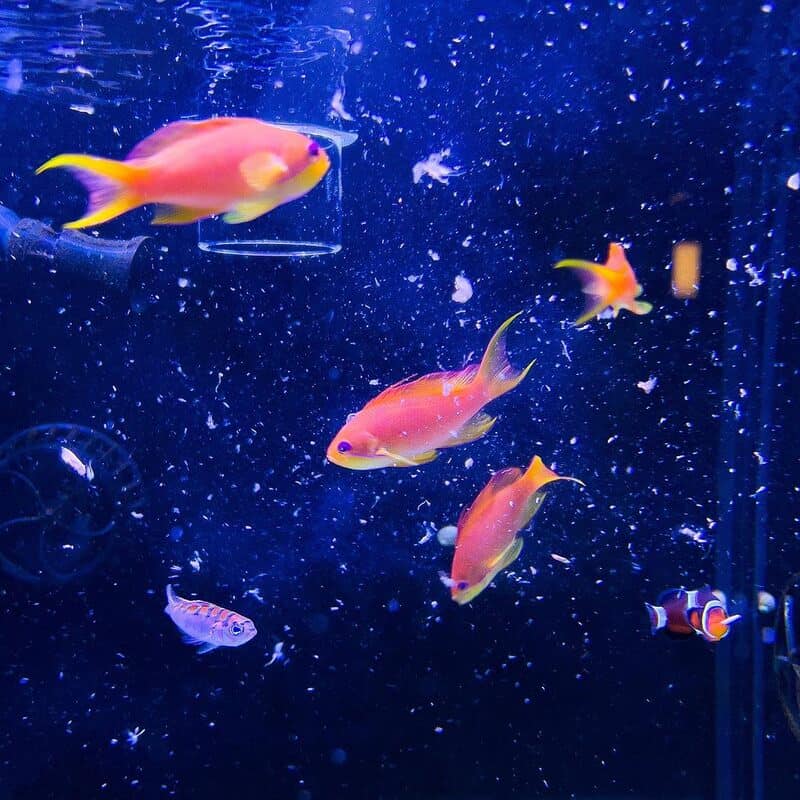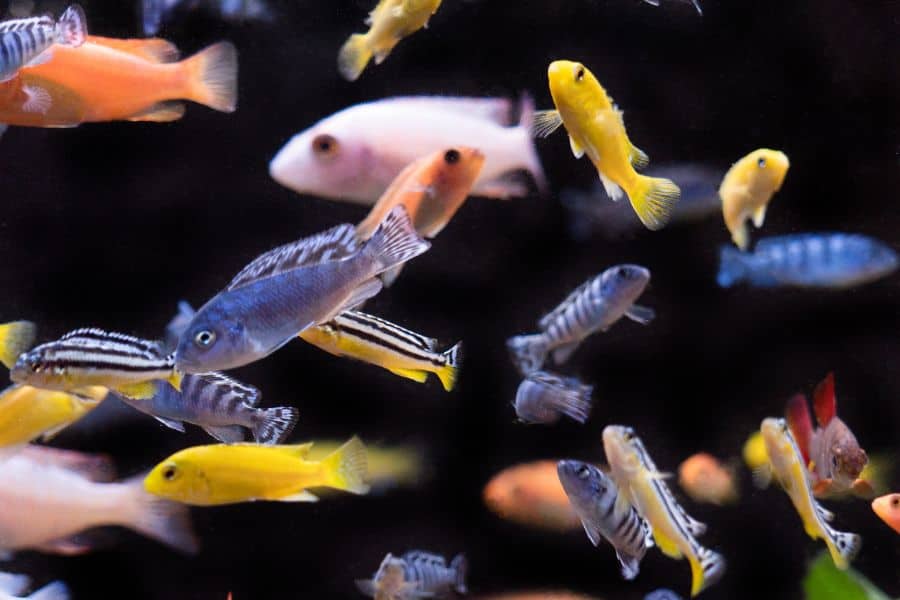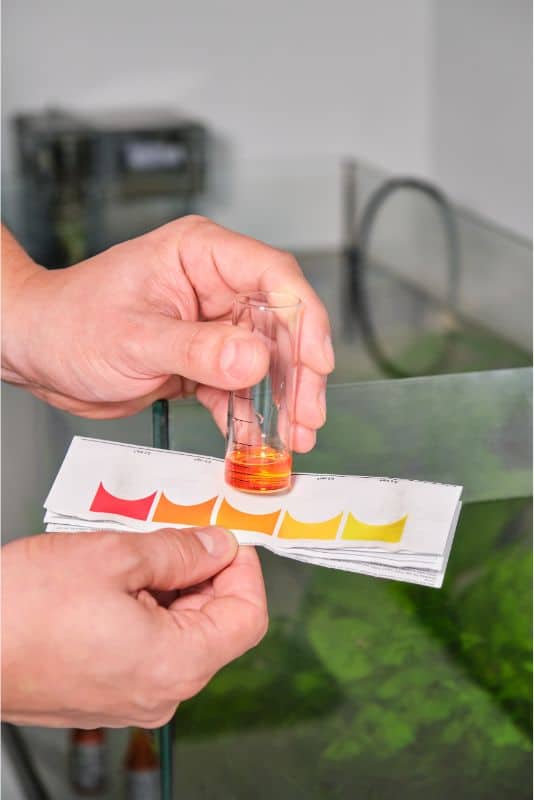Being an aquarium owner isn’t always easy. Like with other hobbies, things won’t always go our way. Sometimes, this can be minor, like algae on our plant leaves. Occasionally, it can be something more problematic, like high nitrite levels.
Nitrites are normal in a fish tank, but too much of them can negatively affect your tank’s overall health. High nitrite levels are linked to dirty aquariums and sick fish, something you definitely don’t want in your tank.
Fortunately, there’s a solution for high nitrite levels in aquariums. In this article, we’ll discuss the signs of high nitrites, what causes them, and how you can lower your nitrite levels fast.
What Are Nitrites?
Before we get into the bulk of our article, let’s talk about what nitrites are in the first place.
Nitrites are a colorless and odorless chemical that results from ammonia, which is also a chemical present in aquariums. Ammonia comes from all the waste that accumulates in your tank.
These two are important parts of the waste cycle in your aquarium, also known as the nitrogen cycle. Here’s a basic step-by-step:
- Waste is created in your aquarium.
- Bacteria will break down the waste, resulting in ammonia.
- Nitrifying bacteria called Nitrosomas will break down the ammonia, leading to higher nitrite levels in the water.
- Bacteria called Nitrobacter will oxidize the nitrites, forming nitrates in the process.
It’s worth noting that while ammonia and nitrites are both dangerous and even lethal to fish, nitrates aren’t as harmful, except in extremely high doses. In fact, nitrates are incredibly important for aquarium plant growth, as they can act as a fertilizer.
Unfortunately, sometimes, something interrupts the cycle, and nitrites don’t get converted into nitrates. When this happens, nitrite levels can skyrocket, and things can get bad pretty fast.
Signs of High Nitrites in Aquarium
How do you know that you’re suffering from increased nitrite levels? You’ll see the symptoms in your fish.
Here are some signs of high nitrites in aquarium:
- Lethargy
- Reduced or lack of appetite
- Fraying or shredded fins
- Reddish coloration on skin
- Discoloration of the eyes
- Odd swimming patterns
- Visible spots, streaks, or patches on body
If you see any of these in your fish, you could be dealing with high nitrites. If you want to know for sure, you can use a tester like API Nitrite Test Kit. This will confirm whether you have high nitrite levels in your tank.
How to Lower High Nitrites Fast
Since high nitrite levels can be deadly to your fish, let’s talk about how to lower nitrites fast before getting to the causes.
There are two proven steps to lowering nitrite levels in an aquarium.
1. Do a Partial Water Change
Nitrites can be found in your water, so it makes sense that replacing your old water with fresh, clean water can dilute their amount and make the water less poisonous to your fish.
Depending on how large your aquarium is, you can do a 25%-50% water change. Anything larger than 50% is generally not recommended, as it can shock your fish.
2. Add Nitrifying Bacteria
After changing the water, you can add some nitrifying bacteria. Nitrifying bacteria are the beneficial bacteria that break down nitrites and turn them into the less toxic, more helpful nitrates.
Luckily, you’ve got some options on the market:
- API Quick Start
- Tim’s Aquatics Freshwater One & Only Nitrifying Bacteria
- Fritz Aquatics FritzZyme 7 Nitrifying Bacteria for Fresh Water
These three are meant to help speed up the nitrogen cycle of new aquariums, also known as uncycled tanks, by introducing beneficial bacteria.
However, they’re also a good option if you’re dealing with nitrite levels. That’s because by adding more beneficial bacteria, you can also hasten the process of converting nitrite into nitrates.
That said, keep in mind that these aren’t long-term solutions. If you don’t solve the actual problem, your nitrite levels will simply increase again. You need to deal with the actual cause in order to solve the problem long-term.
What Causes High Nitrites in Fish Tank and How to Fix Them
So, exactly what causes high nitrites in fish tank? There are many different reasons, which we’ll discuss below. We’ll also include how to fix nitrite levels in fish tank depending on what caused it to rise in the first place.
Overstocking
Overstocking refers to having too many occupants in your tank.
Animals produce waste, which turns to ammonia. In other words, the more animals you have, the more waste you have. Therefore, the faster ammonia builds up and turns to nitrites.
This is especially true for species like Goldfish, Plecos, and Loaches, although even small animals like snails can produce a lot of waste if you have too much of them in your tank.
How to Solve Overstocking
The best way to reduce nitrites in an aquarium with too many occupants is to simply reduce them. Maybe you can transfer some of them to a different tank or start a brand new tank entirely.
Make sure you do this gradually, though. Doing it too fast can shock the tank ecosystem and create a new biological imbalance that will lead to new problems.
Overfeeding

Overfeeding your fish doesn’t just harm them directly. Aside from the obvious issues like constipation and indigestion, it can also harm your aquarium’s nitrogen cycle.
How does this happen? Well, sometimes, not all food gets eaten, turning them into waste material.
This results in a dirtier aquarium, which causes ammonia to build up faster and leads to higher nitrite levels. It can even cause your tank to become cloudy.
How to Solve Overfeeding
It’s never good to overfeed your fish, regardless if your nitrite levels are normal or not. Depending on the species, you should only feed them what they can eat in 1-2 minutes.
As mentioned above, overfeeding your fish can not only make your tank dirty but it can also give your fish painful digestive issues. One of the worst examples is swim bladder disorder, which can be caused by regular indigestion and constipation.
If your fish are constantly leaving leftovers behind, though, you can use a gravel siphon to vacuum all the uneaten food. This will prevent the food from rotting in your tank and increasing the ammonia and nitrite levels.
Dead Plants and Animals
Dead animals can also contribute to high nitrite levels, as their bodies will decompose and turn to waste.
At the same time, if you have plants in your aquarium, it’s important not to neglect their care. Even something as small as decaying leaves can lead to higher ammonia and nitrite levels.
How to Solve Dead Plants and Animals
Death is inevitable in any aquarium. It’s sad, but true. You can be the best fishkeeper in the world, and you’re still bound to experience death.
Therefore, the only way to solve this particular issue is to stay on top of your tank maintenance.
This is especially true if you have a large community tank with plenty of small animals. After all, it’s so easy to miss small fish like Guppies or Tetras.
We’ve had ammonia spikes in the past that seemed to have come out of nowhere, only to find out that a small fish or snail had died and gone unnoticed. If we hadn’t removed them immediately, the nitrite level would’ve been the next one to go up.
For plants, make sure they’re well cared for and that you regularly trim them. If you have dead plant material in your aquarium, like rotting stems or dead leaves, remove them as soon as possible.
Related: Aquarium Plants to Reduce Nitrates
Poor Tank Maintenance
Speaking of maintenance, it’s no secret that the best aquariums are those that are well-maintained.
Aquariums that aren’t maintained are bound to encounter many issues, more than just high nitrite levels. You’ve got dirty water, dirty tank walls, unhealthy fish, overgrown plants, and many, many more.
How to Solve Poor Maintenance
The simplest way to solve poor tank maintenance is just to start doing maintenance in your tank.
Sure, there are some aquariums that may not have filters and don’t require regular water changes – check out the Walstad method – but this doesn’t mean they’re no longer maintained.
Even these aquariums will need regular plant trimmings, wall scrubbings, and substrate vacuuming.
And if you’ve got a regular aquarium, you also need to do water changes, filter cleanings, filter media replacement, and other things required for tank maintenance.
Bad Filter
Maybe you’ve been doing everything right, but you still keep getting high nitrite levels. What could be the problem?
Sometimes, the problem could be your filter.
This is particularly true for non-planted tanks. Without plants, your tank will be relying on your filter alone to keep everything clean.
If your filter isn’t working properly, then it could lead to a build-up of waste and higher nitrite levels in your aquarium.
How to Solve Bad Filters
If you think your filter isn’t working as well as it should be, you may want to give it a deep clean or change out the filter media.
You could also change the filter entirely. This can be inexpensive or costly, depending on the size of your tank and how much power you need.
General Tips on How to Prevent High Nitrites in Aquarium
Here are some tips on how to prevent high nitrite levels in your aquarium!
- Don’t overstock your tank. It can be tempting to keep lots of fish in your tank, but an overcrowded tank comes with a whole host of problems.
- Monitor the tank for signs of ammonia. Ammonia leads to nitrites, so if you can keep your ammonia levels in check, you can also prevent high nitrites. The easiest way to do this is by using Seachem Ammonia Alert. Just stick it on your tank wall, and you can see your ammonia levels at a glance.
- Regularly test your water parameters. You can use the API Freshwater Master Test Kit weekly or every time you do a water change to make sure all your parameters are ideal.
- Build a good feeding habit. Feed your fish at regular intervals, and don’t overfeed. If they don’t finish their food within 2 minutes, have a suction ready to vacuum the leftovers.
- Regularly check your filter. It’s important that your filter is working properly 24/7. Don’t forget to replace worn parts whenever necessary.
- Use nitrifying bacteria. You can also use nitrifying bacteria to speed up the nitrogen process. This can help greatly if you’re still cycling your tank.
Read More: High Aquarium pH: Causes, Symptoms, & Cures
Conclusion
As you can see, high nitrites in an aquarium can be caused by a variety of factors, including overstocking, overfeeding, decaying plants or animals, poor maintenance, and bad filtration.
Since high nitrite levels can be harmful to your fish, it’s important to take precautions and monitor your tank regularly for signs. By doing so, you can prevent this chemical from wreaking havoc in your aquarium.
With this guide, you can keep your nitrite levels normal and your fish happy and healthy!

